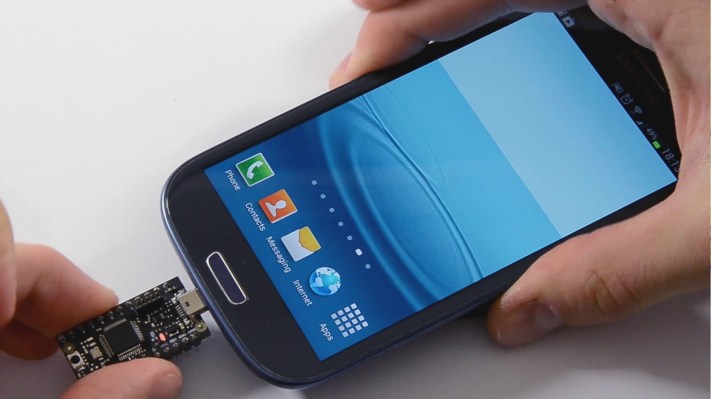Android developers wanting a quicker and easier way to hack around with hardware should point their eyes at this Kickstarter project — called USB2Go — which is aiming to repurpose the micro USB port of your smartphone as a portal for plugging in an ARM Cortex-M3 development board.
The board would then be powered by the phone, doing away with the need for an additional battery (or for wiring things up). Developers also won’t need any ARM programming knowledge either; instead they develop atop USB2Go’s Android API for peripheral control.
The core concept is to make it easier (and potentially cheaper) for Android developers to build external connected gadgets. The USB2Go has an early bird Kickstarter price of $29, rising to $34 after all those early pledges are gone.
“Our competitors are other development boards, but none of them features direct connection to the phone,” USB2Go co-founder Bostjan Mulej tells TechCrunch. “Our main advantages are: small size; it’s powered from the Android device, that means no extra batteries; our software is open sourced.”
From USB2Go’s Kickstarter page:
USB2Go is powered from USB port which provides 5V and 500mA power supply. That amount of power can supply external sensors, lasers, LEDS, imaging sensors, motors, you name it. Because USB2Go has ARM Cortex-M3 low power, high performance core it enables standby mode.
For Android developers with application development experience we have Android API for USB2Go board. This enables you to control all GPIO’s, ADC’s, PWM, timers, RTC, USART, I2C, SPI from Java. This API sends commands to USB2Go board which processes the commands and responds to them, it’s really simple to use without any ARM core knowledge. Programming syntax is very similar to what you are used to.
They recommend developers using Android Studio from Google and Eclipse to create projects using the hardware. But for hobbyist users they have also created a graphical app building tool with drag and drop tools to quickly start playing around.
The Slovenian duo behind USB2Go has managed to circumvent Kickstarter’s country restrictions (the site does not currently support many European territories) by partnering with a U.S.-based engineer, called Kevin Jordan, who previously worked with another Slovenian Kickstarter project (Red Pitaya).
“We were funding development on our own and now we would like to make this accessible to anyone and build an online community for Android gadgets,” Mulej adds.
The team is actually building two versions of USB2Go: a male version that can be plugged straight into the smartphone as its power source, and a female version — to allow for standalone gadgets — that can be powered from a micro USB charger.
It’s also building a family of accessories to go with the USB2Go development board, such as an Arduino extension board to support the creation of Android-powered Arduino projects.
All this is yet to come, however, as USB2Go is seeking to raise $50,000 to fund development via Kickstarter. And has raised less than $1,000 of that with 29 days left to pull in the rest.
If USB2Go taps enough interested developers to make its project fly it’s aiming to ship to backers next October.
